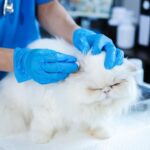Contents
- 1 1. Introduction
- 2 2. The basics of Lovebird Genetics and Mutations
- 3 3. Understanding mutations in lovebirds
- 4 4. Identifying different lovebird mutations
- 5 5. Breeding strategies for desired mutations
- 6 6. Health considerations for lovebirds with genetic mutations
- 7 7. Exploring the future of lovebird genetics
- 8 8. Conclusion
1. Introduction
Lovebirds are beloved pets known for their vibrant colors and playful personalities. However, many people are unaware of the fascinating world of genetics and mutations that exist within these beautiful birds. In this in-depth guide, we will explore the various mutations found in lovebirds, including the 100+ Lovebird Fischer, Rosicoli lovebird, and Peach-Faced Lovebirds. We will delve into the genetics behind these mutations, including both recessive and dominant types. Whether you are a lovebird enthusiast or simply curious about the science behind these colorful creatures, this guide will provide you with a comprehensive understanding of lovebird genetics and mutations.
| Fischer’s Lovebirds | Rosy-faced (Rosicoli) Lovebirds | Peach-faced Lovebirds |
|---|---|---|
| 1. Sky | 1. Ruby | 1. Mango |
| 2. Willow | 2. Rosie | 2. Peachy |
| 3. Sunny | 3. Coral | 3. Apricot |
| 4. Luna | 4. Blaze | 4. Kiwi |
| 5. Tango | 5. Blossom | 5. Papaya |
| 6. Midnight | 6. Sunshine | 6. Berry |
| 7. Emerald | 7. Petal | 7. Tangerine |
| 8. Merlin | 8. Mauve | 8. Lemon |
| 9. Iris | 9. Meadow | 9. Pomegranate |
| 10. Storm | 10. Comet | 10. Nectarine |

2. The basics of Lovebird Genetics and Mutations
Lovebird Genetics and Mutations may sound complex, but understanding the basics can give you a solid foundation for exploring the world of mutations. Lovebirds inherit traits from their parents through a process called genetic transmission. The inheritance of traits is guided by genes, which are segments of DNA that determine specific characteristics.
Lovebird genetics follow a set of rules. For example, recessive mutations can only be expressed when both parents pass on the same mutation. On the other hand, dominant mutations only require one parent to carry the mutation for it to be expressed in the offspring.
In the next section, we will dive deeper into the specifics of lovebird genetics, including how to identify and interpret different genetic codes. By understanding the basics of lovebird genetics, you will be better equipped to appreciate the fantastic array of mutations found in these colorful birds. Stay tuned!

3. Understanding mutations in lovebirds
In this section, we will explore the fascinating world of mutations in lovebirds. Mutations are changes or variations in the genetic code that can result in unique and beautiful characteristics.
Lovebirds exhibit a wide range of mutations, each with its own set of distinct traits. Some common mutations include lutino, pied, and cinnamon. Each mutation is caused by a specific alteration in the genetic code, resulting in variations in feather color, pattern, or structure.
Understanding mutations is crucial for lovebird breeders and enthusiasts. It allows them to predict the potential traits and characteristics of offspring, which helps them selectively breed birds for desired traits.
In the upcoming section, we will delve into the different types of mutations found in lovebirds and discuss how to identify and appreciate their beauty. By gaining insight into the world of mutations, you will be able to recognize and appreciate the marvelous diversity within the lovebird population. Stay tuned for an exciting journey into the colorful world of lovebird mutations!

4. Identifying different lovebird mutations
In this section, we will delve deeper into the fascinating world of lovebird mutations and explore the different types that you may come across. Understanding how to identify these mutations is essential for breeders and enthusiasts who want to selectively breed birds for desired traits.
One of the most common mutations in lovebirds is the lutino mutation. Lutinos have yellow feathers and red eyes, giving them a distinct and vibrant appearance. Another popular mutation is the pied mutation, which creates patches or spots of different colors on the bird’s body. These patches can range from white to yellow to green, adding a unique and eye-catching pattern to the feathers.
The cinnamon mutation is also worth mentioning as it results in a beautiful brownish coloration of the feathers. This mutation can sometimes be mistaken for the natural color of wild lovebirds, but upon closer inspection, the warm, cinnamon tones will stand out.
By learning how to identify these different lovebird mutations, you will be able to appreciate the incredible diversity within the lovebird population. Having this knowledge is not just beneficial for breeders, but also for anyone who simply wants to admire and enjoy the beauty of these unique and mesmerizing birds.
In the next section, we will discuss how to appreciate and care for lovebirds with different mutations, ensuring that they thrive and live happy and healthy lives. Stay tuned for more insights into the colorful world of lovebird genetics and mutations!

5. Breeding strategies for desired mutations
Breeding strategies for desired mutations
If you are a breeder or an enthusiast looking to selectively breed lovebirds for specific mutations, it is important to have a clear understanding of basic breeding strategies. Breeding for desired mutations involves careful planning and consideration to ensure the desired traits are passed on to future generations.
One strategy that breeders often employ is called selective breeding. This involves choosing specific lovebirds with the desired mutation and pairing them together to increase the chances of producing offspring with that particular trait. By carefully selecting the right breeding pairs, you can increase the likelihood of obtaining the desired mutation in the offspring.
Another strategy is known as outcrossing. This involves introducing new bloodlines into your breeding program to enhance genetic diversity. By outcrossing with lovebirds from different bloodlines, you can introduce new mutations or strengthen existing ones in your breeding program.
It is important to note that breeding for mutations requires careful consideration for the overall health and well-being of the lovebirds. Before embarking on any breeding program, it is crucial to have a deep understanding of genetics and seek guidance from experienced breeders or avian experts.

In the next section, we will discuss tips and best practices for the care and well-being of lovebirds with different mutations. Stay tuned for valuable insights on providing the appropriate environment, diet, and socialization for your unique and colorful lovebirds.
6. Health considerations for lovebirds with genetic mutations
Breeding lovebirds for specific mutations can produce visually stunning birds, but it’s crucial to prioritize their health and well-being. Lovebirds with genetic mutations may require additional care and attention to ensure they live happy and healthy lives.
First and foremost, lovebirds with mutations should receive regular check-ups from an avian veterinarian. These specialized vets can monitor their overall health, check for any potential genetic health issues associated with certain mutations, and provide necessary treatments or interventions.
Proper nutrition is also vital for lovebirds with mutations. Some mutations can affect their ability to properly metabolize certain nutrients or can lead to specific dietary requirements. Consult with your avian veterinarian to develop a suitable diet plan that meets their unique needs.
Additionally, lovebirds with mutations may have specific environmental requirements. For example, certain mutations can make them more susceptible to temperature extremes or respiratory issues. By providing a well-regulated and comfortable environment, you can help minimize any potential health problems.

Social interaction is crucial for all lovebirds, including those with genetic mutations. Make sure to provide plenty of mental stimulation and opportunities for socialization to prevent boredom and potential behavioral issues.
By considering these health considerations and providing necessary care, you can ensure that your lovebirds with genetic mutations not only showcase their beautiful traits but also live long and fulfilling lives. In the upcoming section, we will delve into the fascinating world of understanding and identifying different genetic mutations in lovebirds. Stay tuned for an enlightening discussion on the wide range of vibrant mutations and their unique characteristics.
7. Exploring the future of lovebird genetics
In the fast-paced world of avian genetics, new mutations and color variations are being discovered and studied constantly. As breeders and enthusiasts, it is important to stay updated on these developments and understand how they could impact our lovebird populations.
Advancements in genetic research and technology have opened up exciting possibilities for the future of lovebird genetics. Scientists are now able to identify and analyze specific genes responsible for color mutations, allowing for more precise breeding strategies. This knowledge can help us create even more visually striking lovebirds with unique and rare color patterns.
Furthermore, the study of genetics can also provide insights into other aspects of lovebird health and behavior. By unraveling the genetic basis of certain traits, we may gain a better understanding of how genetics influence lovebird personalities, immune system functions, and even potentially uncover genetic markers for disease resistance.
As we move forward, it is essential to strike a balance between producing visually captivating birds and safeguarding their health and well-being. Responsible breeding practices and careful genetic selection will ensure that we maintain healthy and robust lovebird populations for generations to come.

In the next blog section, we will explore some of the cutting-edge research in lovebird genetics and discuss the potential implications for breeders and lovers of these colorful avian companions. Join us as we delve into the ever-evolving world of lovebird genetics!
8. Conclusion
In conclusion, the world of lovebird genetics is a fascinating realm that is constantly evolving. Advancements in genetic research and technology have provided us with a deeper understanding of the unique color variations and mutations that can occur in these beloved avian companions. By staying updated on these developments, breeders and enthusiasts can make informed decisions when it comes to breeding strategies and preserving the health and well-being of lovebird populations.
Throughout this guide, we have explored the importance of responsible breeding practices and the potential implications of genetic research on lovebird health and behavior. By striking a balance between producing visually stunning birds and prioritizing their overall health, we can ensure the longevity and vibrancy of lovebird populations for years to come.
As the field of lovebird genetics continues to evolve, we are excited to witness the discoveries and advancements that lie ahead. Join us in our next blog section as we delve into the cutting-edge research and discuss how it may shape the future of lovebird breeding. Stay tuned for more insights into the colorful world of lovebirds!












I really like your blog.. very nice colors & theme.
Did you design this website yourself or did you hire someone
to do it for you? Plz answer back as I’m looking to construct my
own blog and would like to find out where u got this from.
cheers
I must thank you for the efforts you’ve put in penning
this blog. I’m hoping to view the same high-grade blog posts from
you in the future as well. In fact, your creative writing abilities has inspired me to get my own website now 😉